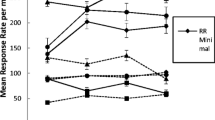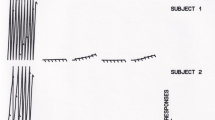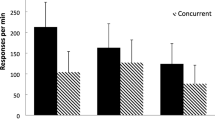Abstract
Compliance with shaped guesses about response rate on reinforcement schedules was studied as a function of schedule randomness and monitoring. Twenty college students were exposed to a random-interval (RI) schedule, 20 to a fixed-interval (FI) schedule with a videotaped performance, and 20 to an FI schedule alone. In comparison to the FI schedule alone, compliance with rate guesses was more likely on the FI schedule when compliance was videotaped, and on the RI schedule alone. No difference was found between the RI and videotape groups. Findings of schedule insensitivity, like those explored here, are discussed in the context of a traditional signal-detection framework.
Similar content being viewed by others
References
CAPOVILLA, F. C., & HINELINE, F. C. (1989, May). Compliance: Effects of instruction source (instructor vs. noninstructor), instruction format (command vs. advice), and instruction-schedule relations (correspondence vs. opposition) upon frequency and magnitude of instruction following, instruction disregarding, and instruction counterreacting on the part of undergraduate students serving as subjects. Paper presented at the Association for Behavior Analysis, Milwaukee, WI.
CATANIA, A. C., MATTHEWS, B. A., SHIMOFF, E. (1982). Instructed versus shaped human verbal behavior: Interactions with nonverbal responding. Journal of the Experimental Analysis of Behavior, 38, 233–248.
CERUTTI, D. T. (1989). Discrimination theory of rule-governed behavior. Journal of the Experimental Analysis of Behavior, 51, 259–276.
CERUTTI, D. T. (1991). Discriminative versus reinforcing properties of schedules as determinants of schedule insensitivity in humans. The Psychological Record, 41, 51–67.
COTTREL, N. B., WACK, D. L., SEKERAK, G. J., & RITTLE, R. H. (1968). Social facilitation of dominant responses by the presence of an audience and the mere presence of others. Journal of Personality and Social Psychology, 9, 245–250.
DAVIDSON, M., & MCCARTHY, D. (1980). Reinforcement for errors in a signal-detection procedure. Journal of the Experimental Analysis of Behavior, 34, 35–47.
GALIZIO, M. (1979). Contingency-shaped and rule-governed behavior: Instructional control of human loss avoidance. Journal of the Experimental Analysis of Behavior, 31, 53–70.
GALIZIO, M., JACKSON, L. A., & STEELE, F. O. (1979). Enforcement symbols and driving speed: The overreaction effect. Journal of Applied Psychology, 64, 311–315.
GREEN, D. M., & SWETS, J. A. (1966). Signal detection theory and psychophysics. New York: Wiley.
HAYES, S. C., ROSENFARB, I., WULFERT, E., MUNT, E. D., KORN, Z., & ZETTLE, R. D. (1985). Self-reinforcement effects: An artifact of social-standard setting? Journal of Applied Behavior Analysis, 18, 201–214.
LATTAL, K. A. (1975). Reinforcement contingencies as discriminative stimuli. Journal of the Experimental Analysis of Behavior, 23, 241–246.
MATTHEWS, B. A., CATANIA, A. C., & SHIMOFF, E. (1985). Effects of uninstructed verbal behavior on nonverbal responding: Contingency descriptions versus performance descriptions. Journal of the Experimental Analysis of Behavior, 43, 155–164.
MATTHEWS, B. A., SHIMOFF, E., CATANIA, A. C., & SAGVOLDEN, T. (1977). Uninstructed human responding: Sensitivity to ratio and interval contingencies. Journal of the Experimental Analysis of Behavior, 27, 453–467.
NEVIN, J. A., OLSON, K., MANDELL, C., & YARENSKI, P. (1975). Differential reinforcement and signal detection. Journal of the Experimental Analysis of Behavior, 24, 355–367.
PETERSON, R. F., MERWIN, M. R., MOYER, T. J., & WHITEHURST, G. J. (1971). Generalized imitation: The effects of experimenter absence, differential reinforcement, and stimulus complexity. Journal of Experimental Child Psychology, 12, 114–128.
SKINNER, B. F. (1953). Science and human behavior. New York: Macmillan.
TORGRUD, L. J., & HOLBORN, S. W. (1990). The effects of verbal performance descriptions on nonverbal operant responding. Journal of the Experimental Analysis of Behavior, 54, 273–291.
WEINER, H. (1969). Controlling human fixed-interval performance. Journal of the Experimental Analysis of Behavior, 12, 349–373.
WEINER, H. (1970). Human behavioral persistence. The Psychological Record, 20, 445–456.
WILLIAMS, K., HARKINS, S., & LATANE, B. (1981). Identifiability as a determinant of social loafing: Two cheering experiments. Journal of Personality and Social Psychology, 40, 303–311.
Author information
Authors and Affiliations
Additional information
This material is based upon work supported under a National Science Foundation graduate fellowship. I wish to give special thanks to Phil Hineline for his suggestions and support and to Julie Schweitzer for her editorial comments.
Rights and permissions
About this article
Cite this article
Cerutti, D.T. Compliance with Instructions: Effects of Randomness in Scheduling and Monitoring. Psychol Rec 44, 259–269 (1994). https://doi.org/10.1007/BF03395133
Published:
Issue Date:
DOI: https://doi.org/10.1007/BF03395133




